Estimation of Airspeed, Angle of Attack, and Sideslip for Small Unmanned Aerial Vehicles (UAVs) Using a Micro-Pitot Tube
Abstract
:1. Introduction
2. Theoretical Framework
2.1. Kinematic Model
2.2. Error Analysis
2.3. Measurement Noise Estimation via Kalman Filtering
3. Sensor System
- Differential pressure sensor (Freescale Semiconductor MPX2010DP micro-Pitot);
- Static pressure sensor (Bosch Sensortec BMP180);
- IMU (DFRobot 10 DOF MEMS IMU sensor);
- Microcontroller (Arduino Mega 2560).
3.1. Differential Pressure Sensor (MPX2010DP)
3.2. Digital Pressure Sensor (BMP180)
3.3. 10 DOF IMU
3.4. Microcontroller
4. Simulations, Results, and Performance Evaluation
4.1. Pressure-Sensor Calibration
4.2. Indoor Tests—Velocity Estimation
- Speed 0: 0 m/s (for system calibration);
- Speed 1: m/s (measured by the anemometer);
- Speed 2: randomly varying airflow.
4.3. Indoor Tests—AOA, AOS, and Attitude Estimation
- Static data acquisition: the system was fixed and simply surrounded by the constant airflow coming from the fan;
- Pitot tube aligned with the airframe longitudinal axis: the relative velocity was equal to the airflow velocity, and from Equation (4):
5. Conclusions and Further Work
- The alignment of the micro-Pitot tube (differential pressure sensor) to the longitudinal axis of the UAV must be performed very precisely in order to avoid biases in the estimations of the AOA and AOS. Moreover, the sensor must be located reasonably far from the rotary wings (considering a quadcopter or a multirotor VTOL UAV) to avoid turbulent airflow added by the rotors.
- High velocities (>20 m/s) create differential pressure values out of the available sensor range (0.10 kPa at 10 V supply, 0–2 kPa at 5 V supply). This was not an issue for the micro-UAV applications devised by the authors (the system will be installed on a quadcopter with maximum velocity on the order of 10 m/s), but could be a problem for larger aircraft.
- The mass and size requirements of our system (<150 g, typical dimensions of the boxed prototype of 120 × 60 × 30 mm) fit typical mini- and micro-UAV payload constraints, but the power consumption of the system (in the range 1–2W) could significantly reduce the aircraft’s endurance (which was in the order of 15–30 min for typical small UAVs). Therefore, careful engineering considerations must be devised to reduce the impact of the system in terms of flight mission duration.
Author Contributions
Funding
Acknowledgments
Conflicts of Interest
References
- U.S. Army UAS Center of Excellence (ATZQ-CDI-C). Eyes of the Army”—U.S. Army Roadmap for Unmanned Aircraft Systems 2010–2035; Army UAS CoE Staff: Fort Rucker, AL, USA, 2010. [Google Scholar]
- Papa, U. Embedded Platforms for UAS Landing Path and Obstacle Detection. In Studies in Systems, Decision and Control; Springer: New York, NY, USA, 2018; Volume 136. [Google Scholar]
- Nawaz, H.; Ali, H.M.; Massan, S.-U. Applications of unmanned aerial vehicles: A review. 3c Tecnol. 2019. [Google Scholar] [CrossRef]
- González-Jorge, H.; Martínez-Sánchez, J.; Bueno, M.; Arias, A.P. Unmanned aerial systems for civil applications: A review. Drones 2017, 1, 2. [Google Scholar] [CrossRef]
- Shakhatreh, H.; Sawalmeh, A.H.; Al-Fuqaha, A.; Dou, Z.; Almaita, E.; Khalil, I.; Othman, N.S.; Khreishah, A.; Guizani, M. Unmanned Aerial Vehicles (UAVs): A survey on civil applications and key research challenges. IEEE Access 2019, 7, 48572–48634. [Google Scholar] [CrossRef]
- ENAC (Ente Nazionale per l’Aviazione Civile). Regolamento Mezzi aerei a pilotaggio remoto. Amendment 1, 14/07/2020; Enac: Rome, Italy, 2020. [Google Scholar]
- Abdelkrim, N.; Aouf, N. Robust INS/GPS sensor fusion for UAV localization using SDRE nonlinear filtering. IEEE Sens. J. 2010, 10, 789–798. [Google Scholar]
- Gross, J.N.; Gu, Y.; Rhudy, M.B.; Gururajan, S.; Napolitano, M.R. Flight-test evaluation of sensor fusion algorithms for attitude estimation. IEEE Trans. Aerosp. Electron. Syst. 2012, 48, 2128–2139. [Google Scholar] [CrossRef]
- Yang, X.; Mejias Alvarez, L.; Garratt, M. Multi-sensor data fusion for UAV navigation during landing operations. In Proceedings of the Australasian Conference on Robotics and Automation (ACRA 2011), Australian Robotics and Automation Association, Melbourne, Australia, 7–9 December 2011. [Google Scholar]
- Del Pizzo, S.; Papa, U.; Gaglione, S.; Troisi, S.; Del Core, G. A vision-based navigation system for landing procedure. Acta IMEKO 2018, 7, 102–109. [Google Scholar] [CrossRef]
- Ariante, G.; Papa, U.; Ponte, S.; Del Core, G. UAS for positioning and field mapping using LIDAR and IMU sensors data: Kalman filtering and integration. In Proceedings of the IEEE 5th International Workshop on Metrology for AeroSpace (MetroAeroSpace), Turin, Italy, 19–21 June 2019. [Google Scholar]
- Wang, B.H.; Wang, D.B.; Ali, Z.A.; Ting, B.T.; Wang, H. An overview of various kinds of wind effects on unmanned aerial vehicle. Meas. Control. 2019, 52, 731–739. [Google Scholar] [CrossRef]
- Tian, P.; Chao, H.; Rhudy, M.; Gross, J.; Wu, H. Wind sensing and estimation using small fixed-wing unmanned aerial vehicles: A survey. J. Aerosp. Inf. Syst. 2021, 18, 132–143. [Google Scholar] [CrossRef]
- Shimura, T.; Inoue, M.; Tsujimoto, H.; Sasaki, K.; Iguchi, M. Estimation of wind vector profile using a hexarotor unmanned aerial vehicle and its application to meteorological observation up to 1000 m above surface. J. Atmos. Ocean. Technol. 2018, 35, 1621–1631. [Google Scholar] [CrossRef]
- Petrich, J.; Subbarao, K. On-board wind speed estimation for Uavs. In Proceedings of the AIAA Guidance, Navigation, and Control Conference, Portland, OR, USA, 8–11 August 2011. [Google Scholar]
- Watkins, S.; Milbank, J.; Loxton, B.J.; Melbourne, W.H. Atmospheric winds and their implications for microair vehicles. AIAA J. 2006, 44, 2591–2600. [Google Scholar] [CrossRef]
- Langelaan, J.W.; Alley, N.; Neidhoefer, J. Wind field estimation for small unmanned aerial vehicles. J. Guid. Control. Dyn. 2011, 34, 1016–1030. [Google Scholar] [CrossRef]
- Gavrilovic, N.; Benard, E.; Pastor, P.; Moschetta, J.-M. Performance improvement of small UAVs through energy-harvesting within atmospheric gusts. In Proceedings of the AIAA SciTech Forum, Grapevine, TX, USA, 9–13 January 2017. [Google Scholar]
- Johansen, T.A.; Cristofaro, A.; Sorensen, K.; Hansen, J.M.; Fossen, T.I. On estimation of wind velocity, angle-of-attack and sideslip angle of small UAVs using standard sensors. In Proceedings of the International Conference on Unmanned Aircraft Systems (ICUAS), Denver, CO, USA, 9–12 June 2015. [Google Scholar]
- Perry, J.; Mohamed, A.; Johnson, B.; Lind, R. Estimating angle of attack and sideslip under high dynamics on small UAVs. In Proceedings of the ION GNSS 21st International Technical Meeting of the Satellite Division, Savannah, GA, USA, 16–19 September 2008; pp. 1165–1173. [Google Scholar]
- Sankaralingam, L.; Ramprasadh, C. A comprehensive survey on the methods of angle of attack measurement and estimation in UAVs. Chin. J. Aeronaut. 2019, 33, 749–770. [Google Scholar] [CrossRef]
- Ramprasadh, C.; Prem, S.; Sankaralingam, L.; Deshpande, P.; Dodamani, R. A simple method for estimation of angle of attack. IFAC-Pap. 2018, 51, 353–358. [Google Scholar] [CrossRef]
- Ramprasadh, C.; Arya, H. Multistage-fusion algorithm for estimation of aerodynamic angles in mini aerial vehicle. J. Aircr. 2012, 49, 93–100. [Google Scholar] [CrossRef]
- Ariante, G.; Papa, U.; Ponte, S.; Del Core, G. Velocity and attitude estimation of a small unmanned aircraft with micro Pitot tube and Inertial Measurement Unit (IMU). In Proceedings of the IEEE 7th International Workshop on Metrology for Aerospace (MetroAer-oSpace), Pisa, Italy, 22–24 June 2020. [Google Scholar]
- De Marina, H.G.; Pereda, F.J.; Giron-Sierra, J.M.; Espinosa, F. UAV attitude estimation using unscented Kalman filter and TRIAD. IEEE Trans. Ind. Electron. 2011, 59, 4465–4474. [Google Scholar] [CrossRef] [Green Version]
- Zhang, Q.; Xu, Y.; Wang, X.; Yu, Z.; Deng, T. Real-time wind field estimation and pitot tube calibration using an extended Kalman filter. Mathematics 2021, 9, 646. [Google Scholar] [CrossRef]
- Beard, R.W.; McLain, T.W. Small Unmanned Aircraft: Theory and Practice; Princeton University Press: Princeton, NJ, USA, 2012. [Google Scholar]
- Cai, G.; Chen, B.M.; Lee, T.H. An overview on development of miniature unmanned rotorcraft systems. Front. Electr. Electron. Eng. China 2009, 5, 1–14. [Google Scholar] [CrossRef]
- Quan, Q. Introduction to Multicopter Design and Control; Springer: Singapore, 2017. [Google Scholar]
- Yechout, T.; Morris, S.L.; Bossert, D.E.; Hallgren, W.F. Introduction to aircraft flight mechanics: Performance, static stability, dynamic stability, and classical feedback control. In AIAA Education Series; American Institute of Aeronautics and Astronautics, Inc.: Reston, VA, USA, 2003. [Google Scholar]
- International Organization for Standardization (ISO). Standard Atmosphere; ISO: London, UK, 1975. [Google Scholar]
- Ghilani, C.D. Adjustment Computations—Spatial Data Analysis, 5th ed.; John Wiley and Sons, Inc.: Hoboken, NJ, USA, 2010. [Google Scholar]
- Grewal, M.S.; Andrews, A.P. Kalman Filtering—Theory and Practice Using MATLAB®, 3rd ed.; John Wiley and Sons, Inc.: Hoboken, NJ, USA, 2008. [Google Scholar]
- NXP B., V. MPX2010 Series—10 kPa Temperature Compensated Pressure Sensors—Product Datasheet. Rev. 14. 2021. Available online: https://www.nxp.com/docs/en/data-sheet/MPX2010.pdf (accessed on 1 July 2021).
- Bosch Sensortec. BMP180 Digital Pressure Sensor, Rev. 2.8, Doc. No. BST-BMP180-DS000-12. 2015. Available online: https://git.wapakema.de/walter/Wetterstation/raw/commit/5d7e482b2baaa35a205b06021f282d10bd271cd3/python/BMP280.pdf (accessed on 1 July 2021).
- DFRobot, 2018. 10-Dof MEMS IMU Sensor V2.0. Available online: https://www.dfrobot.com/wiki/index.php/10_DOF_Mems_IMU_Sensor_V2.0_SKU:_SEN0140 (accessed on 1 July 2021).
- Analog Devices. Small, Low Power, 3-Axis ±3g Accelerometer ADXL335-345. Rev. 0; One Technology Way: Norwood, MA, USA, 2009. Available online: https://www.sparkfun.com/datasheets/Components/SMD/adxl335.pdf (accessed on 1 July 2021).
- Honeywell. 3-Axis Digital Compass IC HMC5883L. Rev E.; Honeywell: Plymouth, MN, USA, 2013. [Google Scholar]
- InvenSense Inc. ITG-3200 Product Specification—Revision 1.7; InvenSense Inc.: Sunnyvale, CA, USA, 2011. [Google Scholar]
- Proster®. Proster TL017 Handheld Anemometer Wind Speed Meter Scale Gauge. 2012. Available online: http://www.prostereu.com/index.php/2015/07/24/tl017/ (accessed on 1 July 2021).
- Romero, M.; Figueroa, R. Low-Pressure Sensing Using MPX2010 Series Pressure Sensors. Application Note AN4010, Rev. 1; Freescale Semiconductors Inc.: Austin, TX, USA, 2005. [Google Scholar]
- Adafruit Industries. DHT11, DHT22 and AM2302 Sensors. 2020. Available online: https://cdn-learn.adafruit.com/downloads/pdf/dht.pdf (accessed on 3 September 2021).
- Merhav, S. Aerospace Sensor Systems and Applications; Springer: New York, NY, USA, 1996. [Google Scholar]
- Gui, P.; Tang, L.; Mukhopadhyay, S. MEMS based IMU for tilting measurement: Comparison of complementary and Kalman filter based data fusion. In Proceedings of the IEEE 10th conference on Industrial Electronics and Applications (ICIEA), Auckland, New Zealand, 15–17 June 2015. [Google Scholar]
- Stančin, S.; Tomazic, S. On the interpretation of 3D gyroscope measurements. J. Sens. 2018, 2018, 1–8. [Google Scholar] [CrossRef] [Green Version]
- Fisher, C.J. Using an Accelerometer for Inclination Sensing. AN-1057 Application Note; Analog Devices Inc.: Norwood, MA, USA, 2010. [Google Scholar]
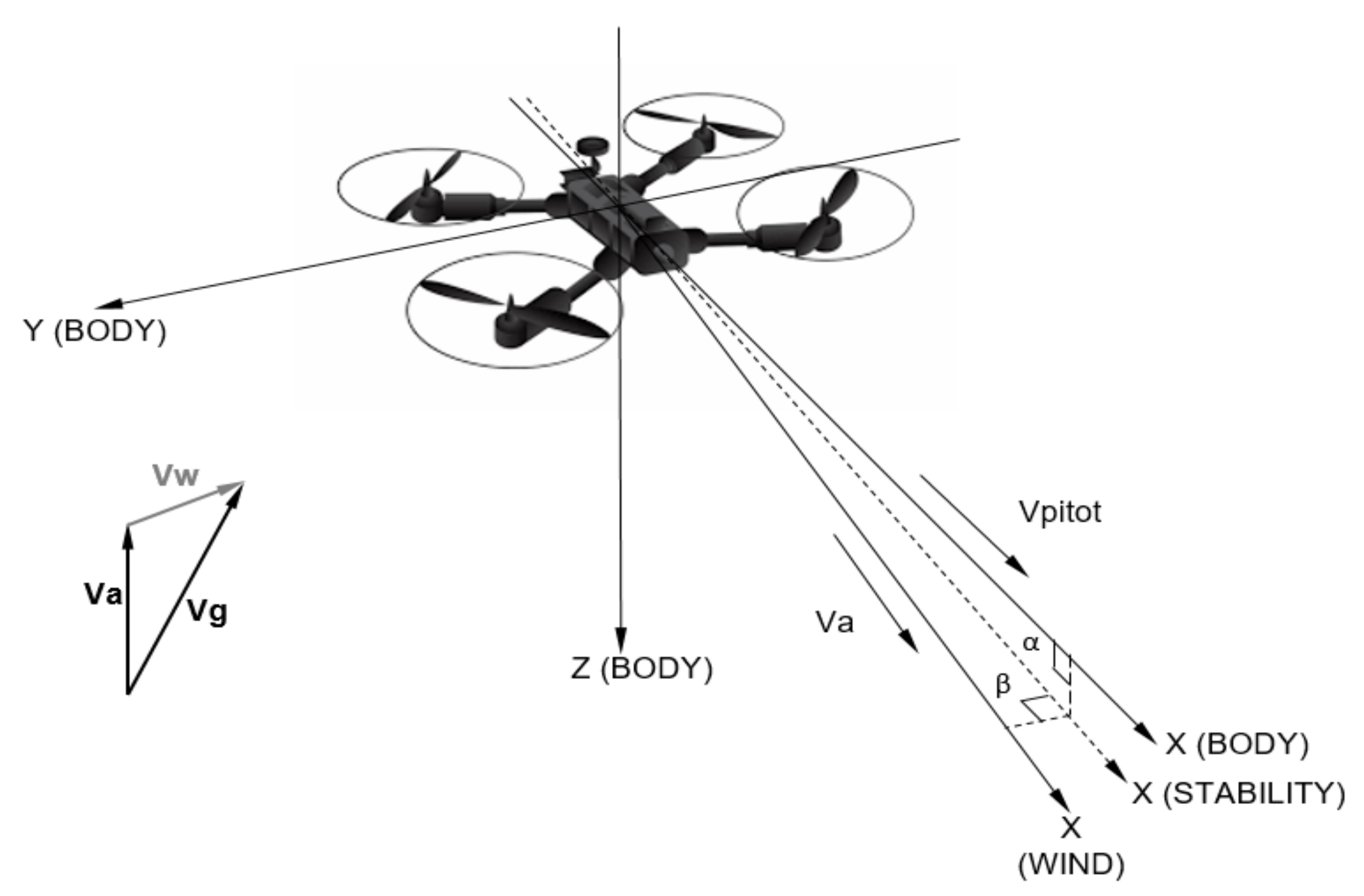




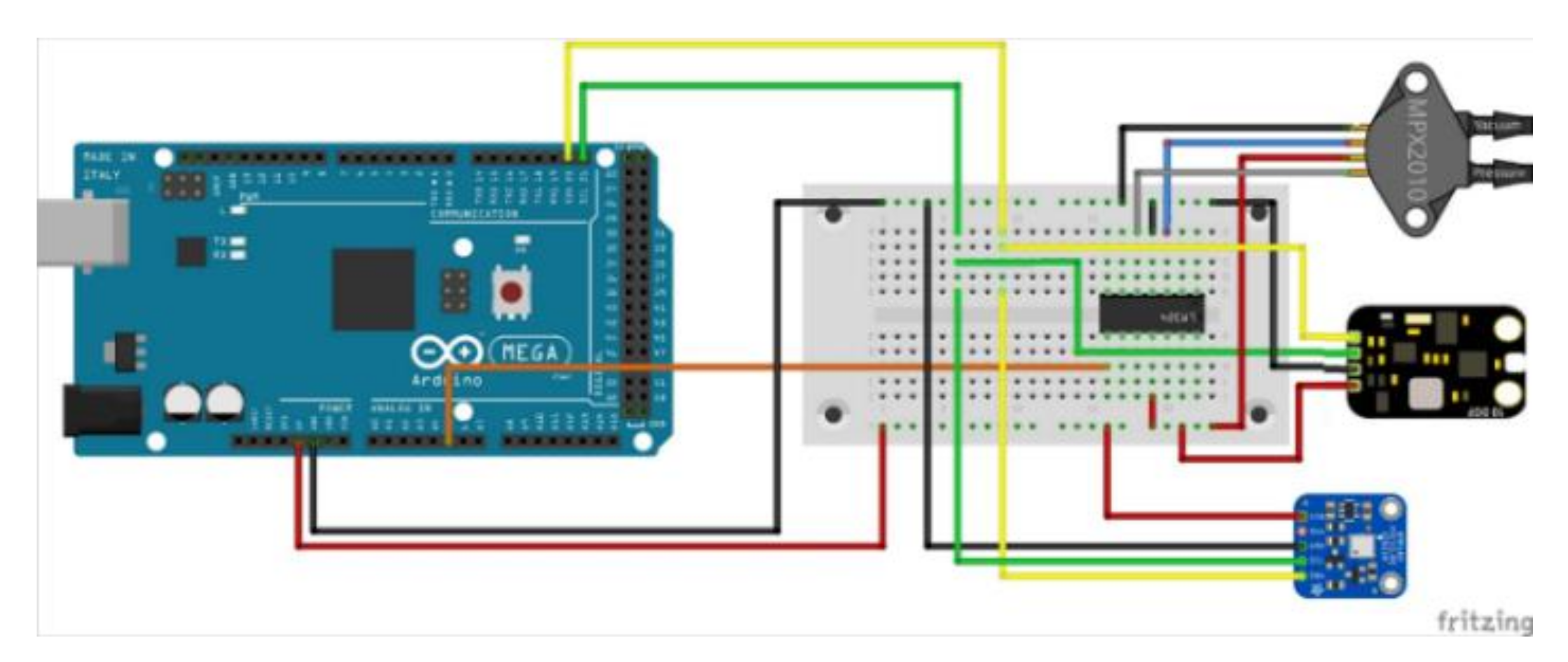

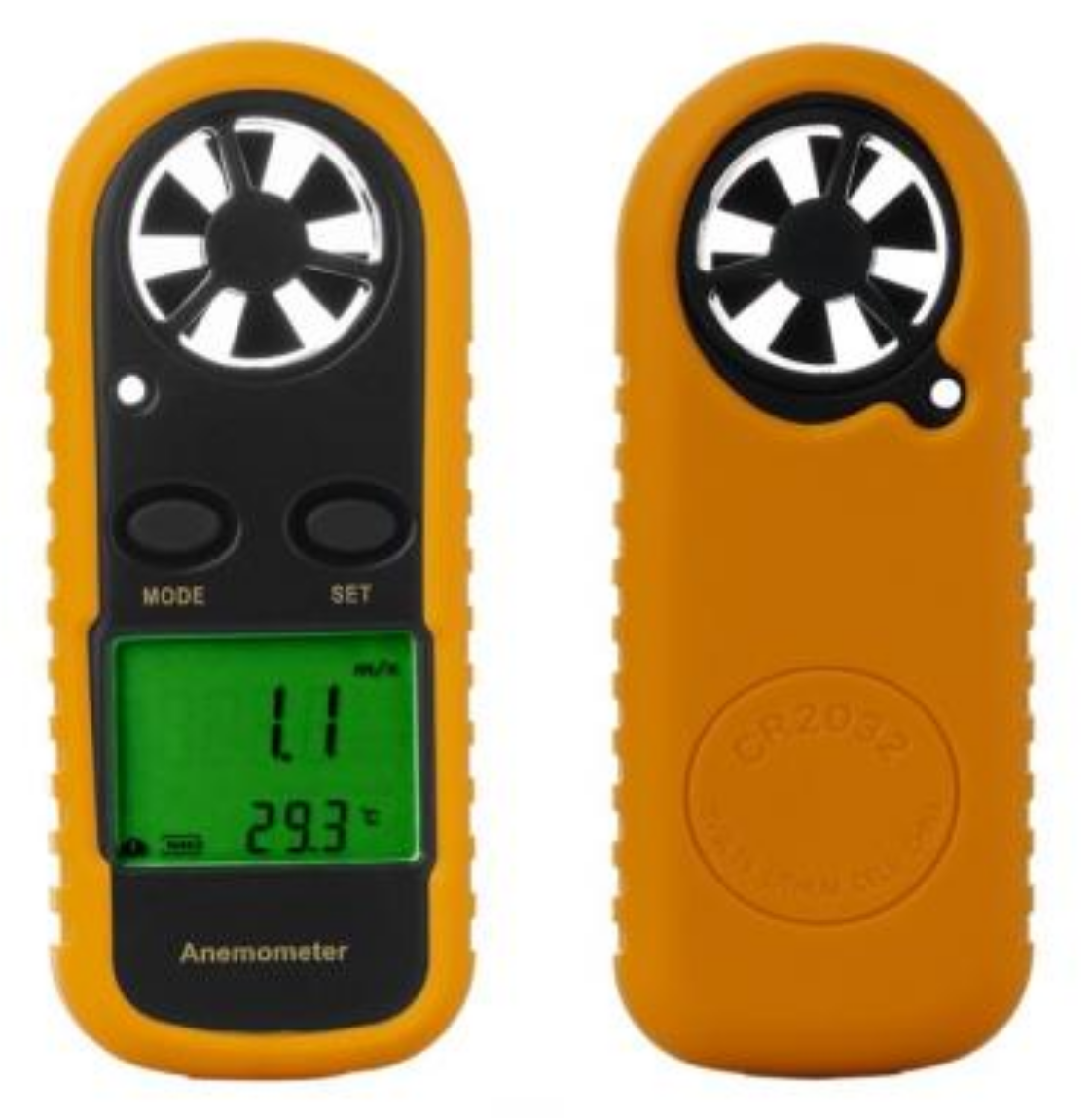

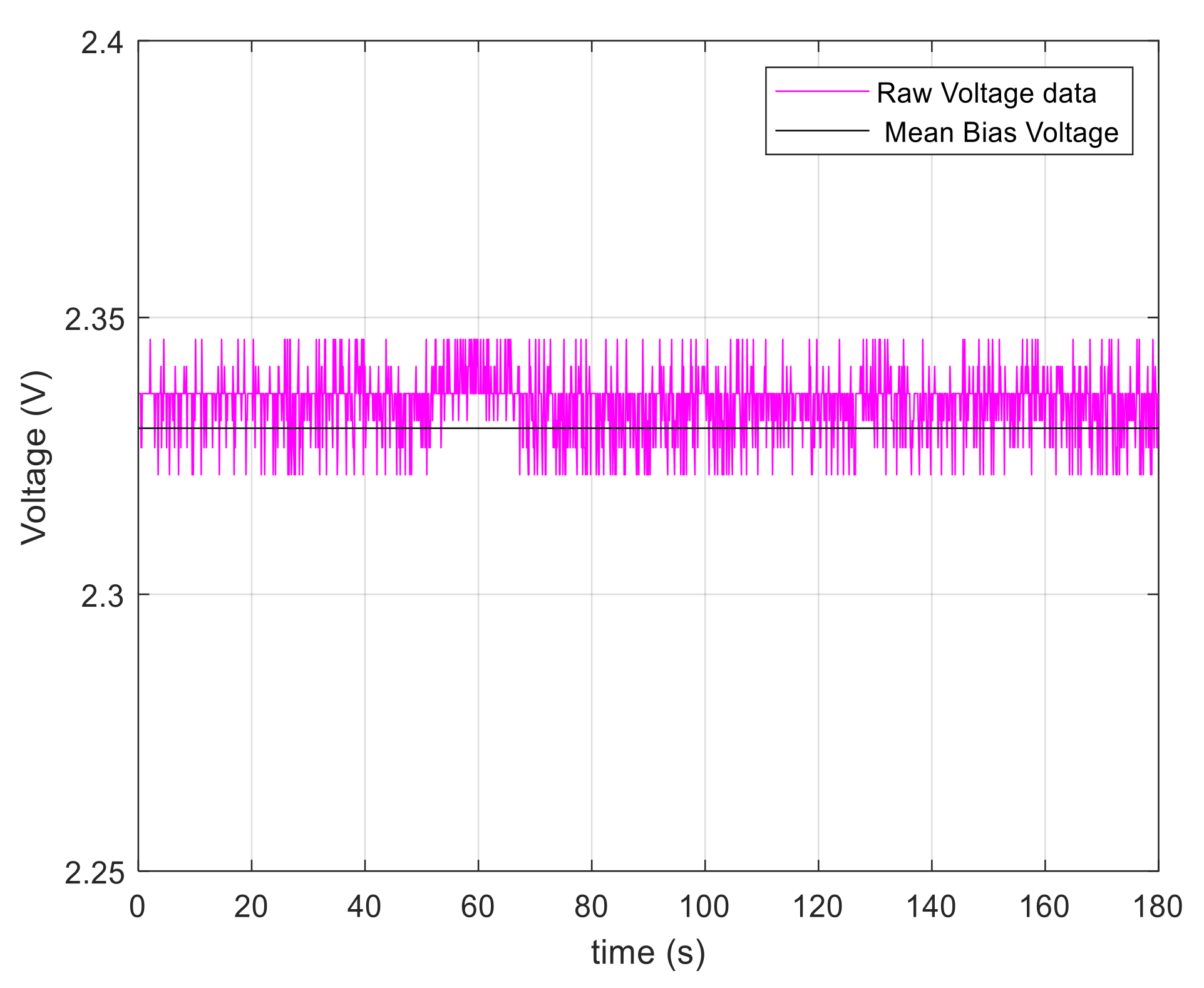
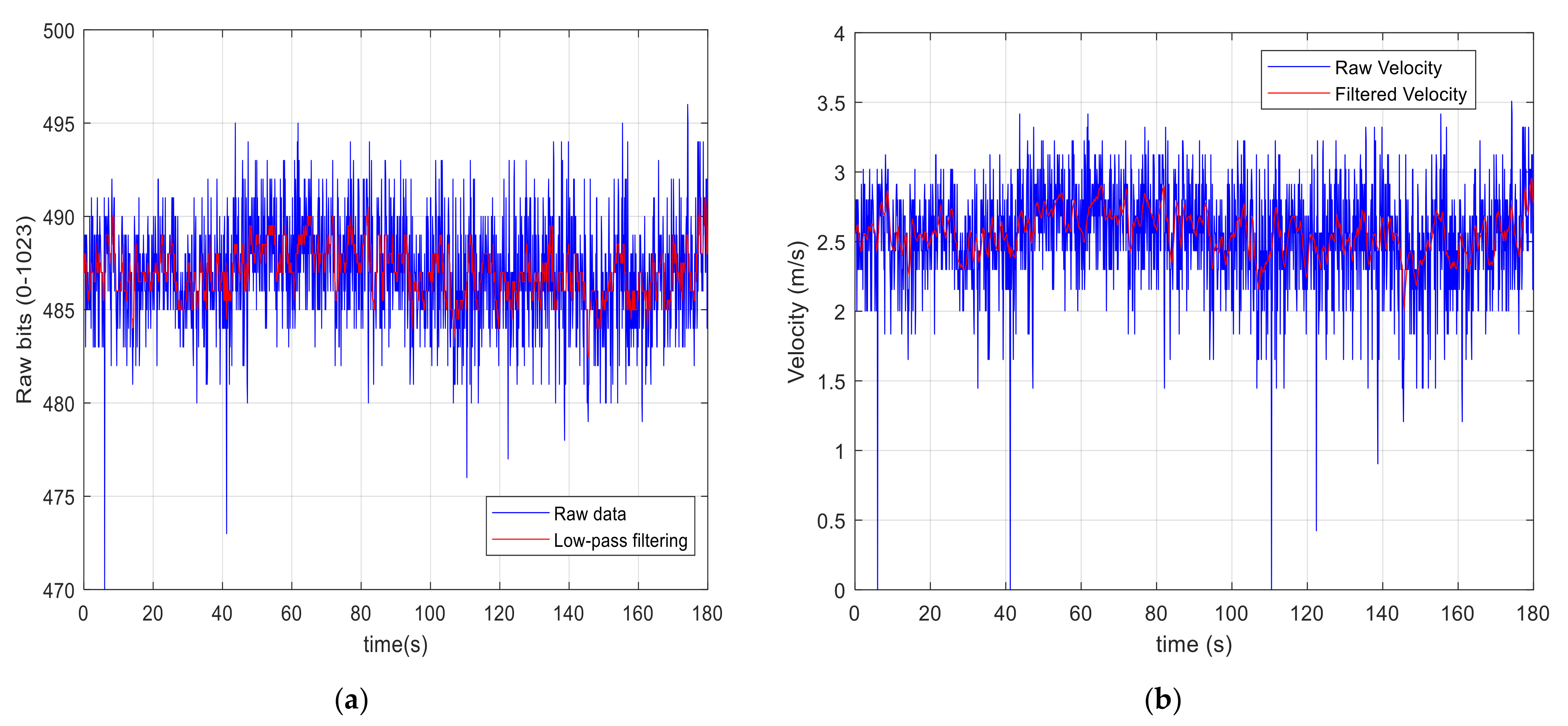
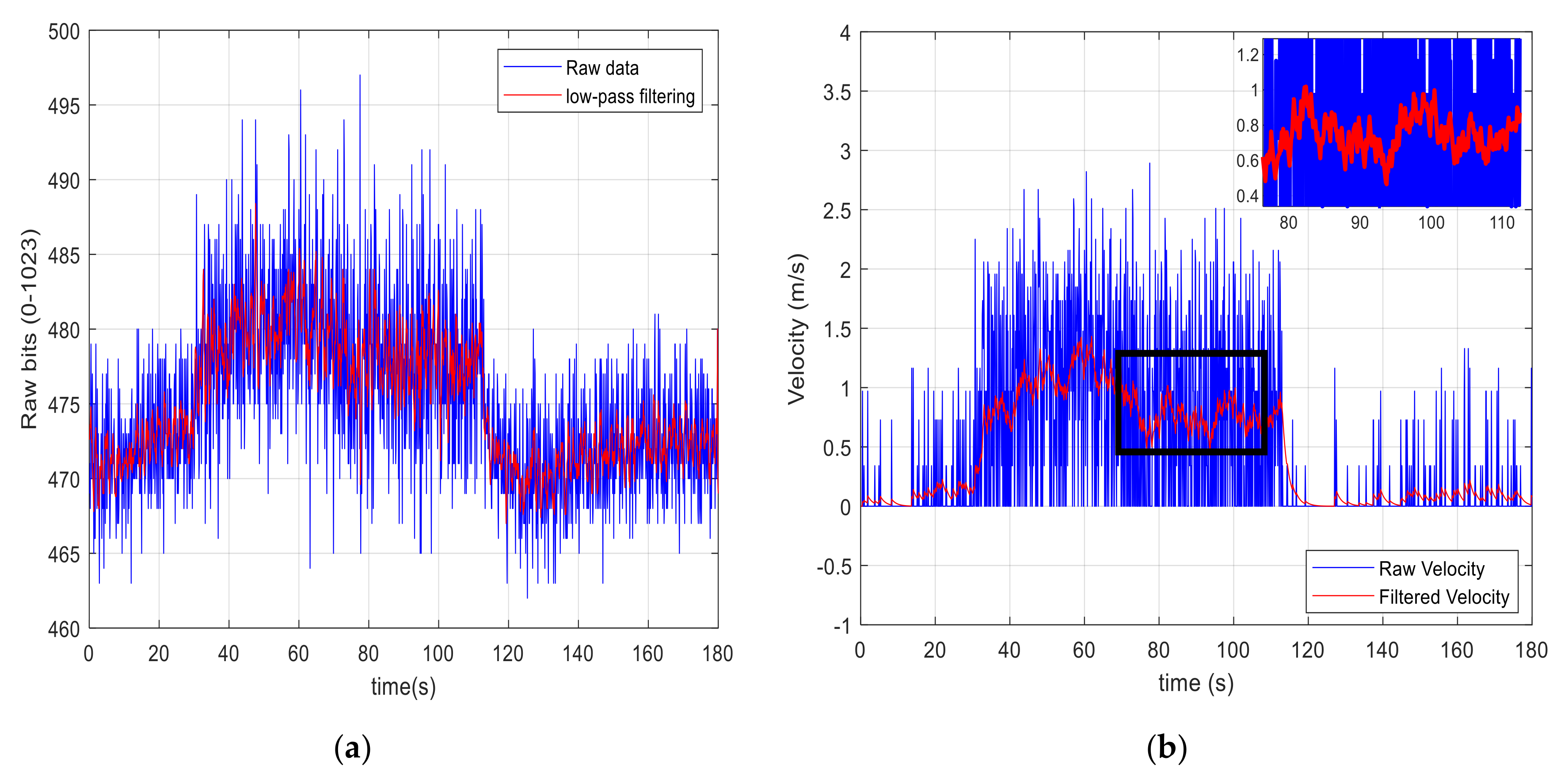


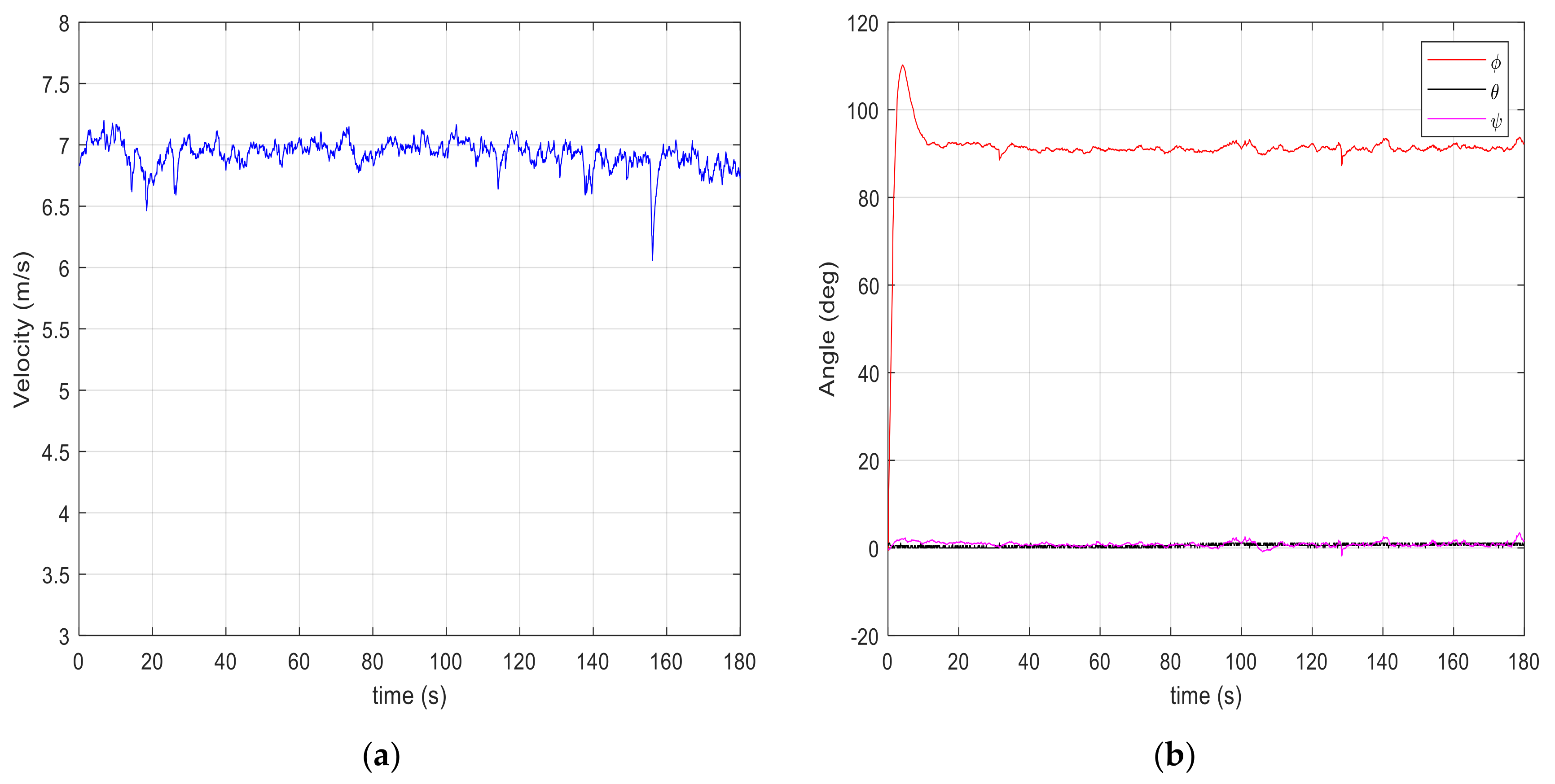
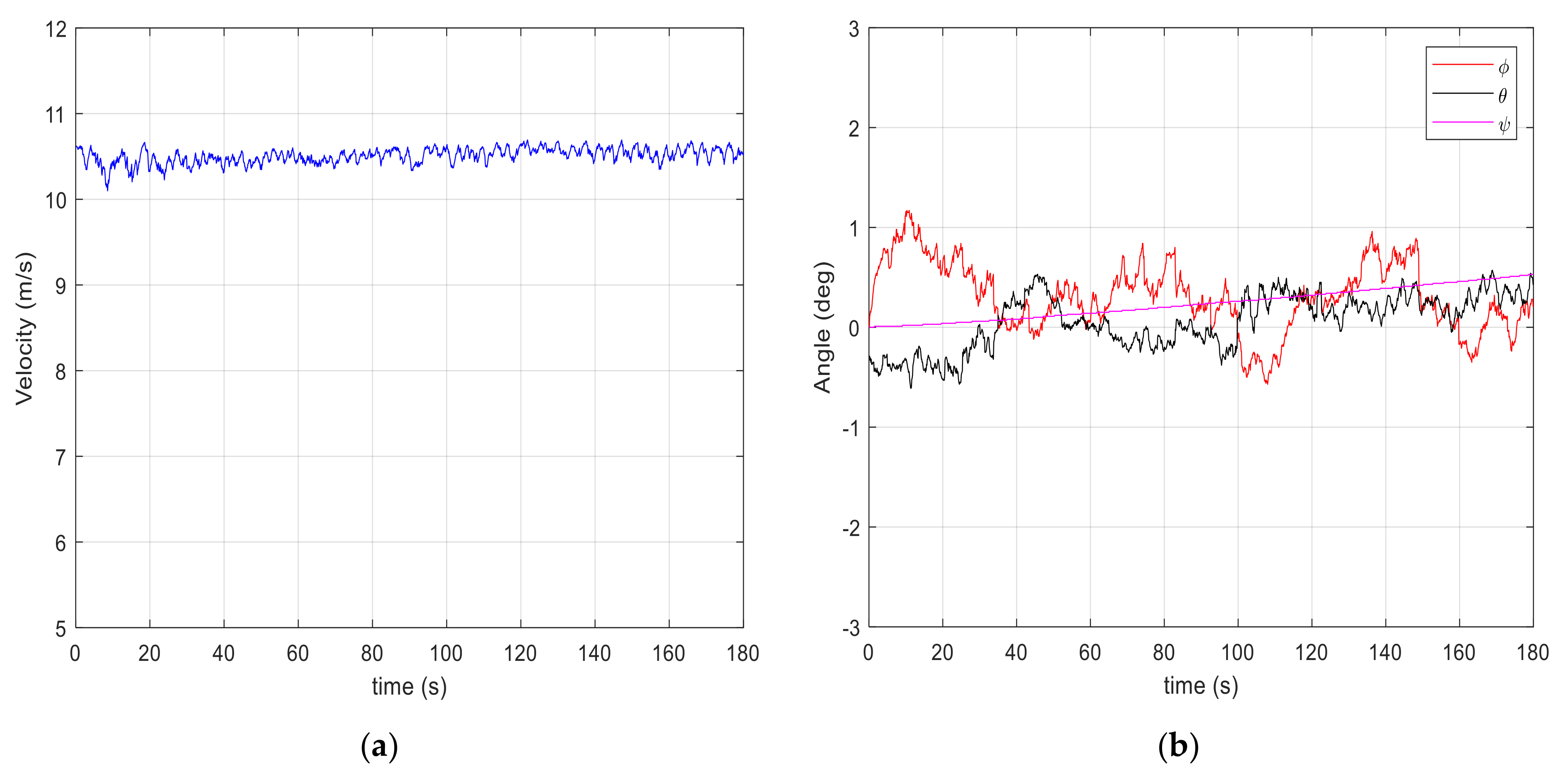
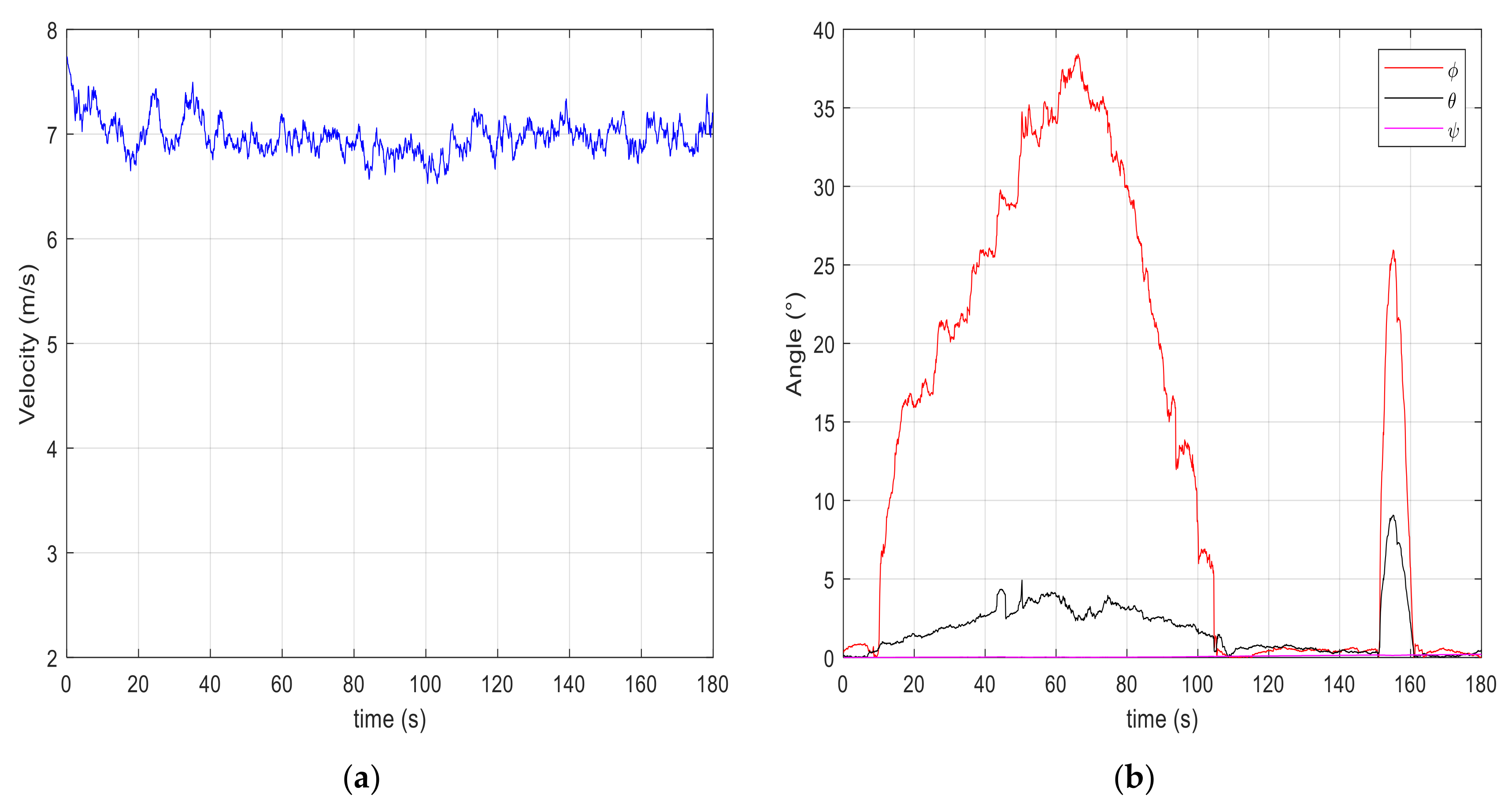
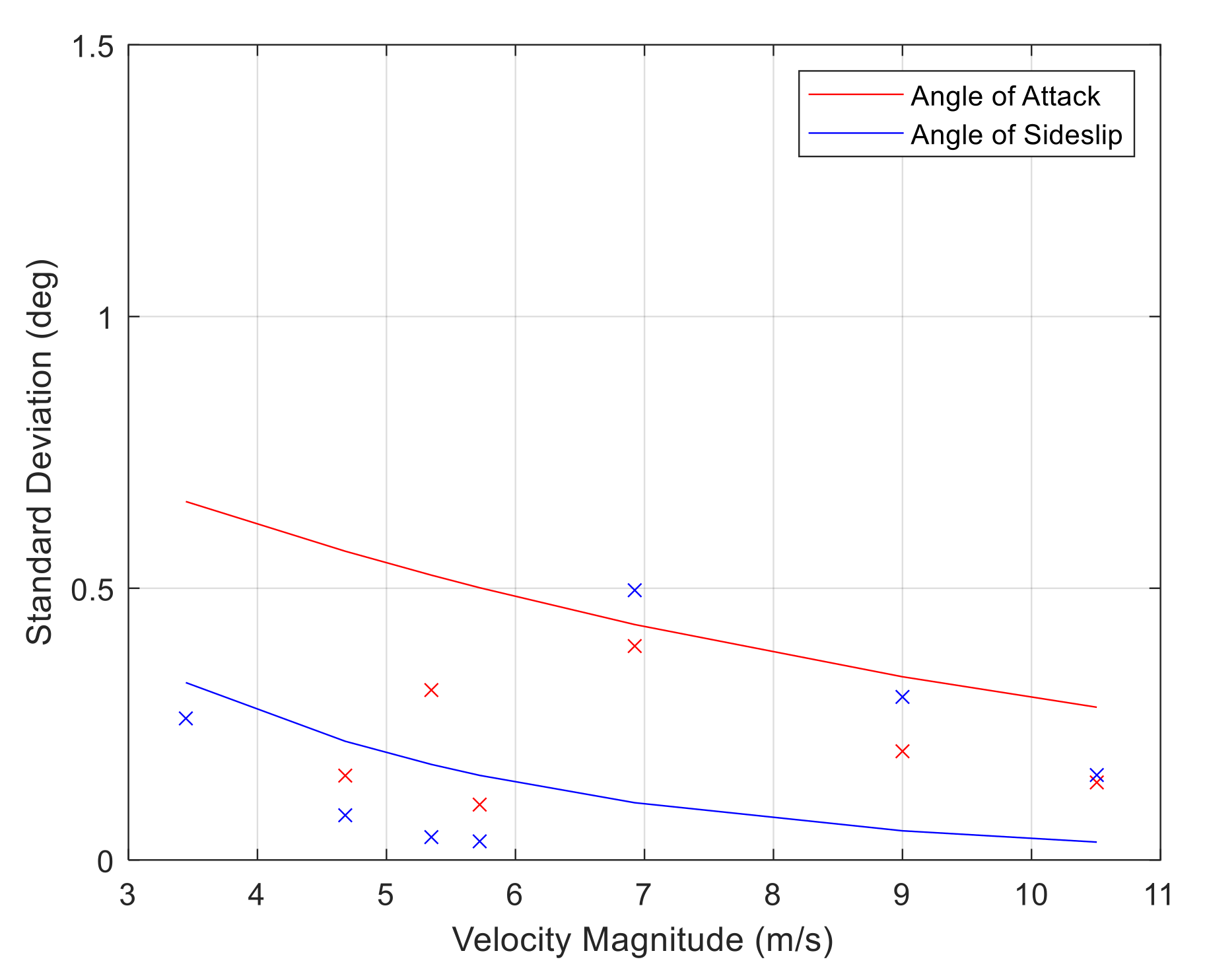
| float KF_nr(float Data) { P += Q; K = P/(P+R); X += K*(Data - X); P = (1-K)*P; return X; } |
| Dimensions, mass | 29 × 29 × 18 mm, <20 g |
| Pressure range, operating temperature | 0–10 kPa, -40 °C–125 °C |
| Supply voltage, current, power consumption | 10 VDC, 6 mA, 60 mW |
| Temperature compensation | 0 °C to +85 °C |
| Full-scale span (VFSS) | 25 mV |
| Offset, sensitivity | Max ± 1 mV, 2.5 mV/kPa |
| Offset stability, linearity | ±0.5% VFSS, max ± 1% VFSS |
| Response time (10% to 90%) | 1 ms |
| Warm-up time | 20 ms |
| Dimensions, mass | 20 × 25 mm, < 5 g |
| Supply voltage, power consumption | 2.5 VDC (typical), < 2 mW |
| Supply current @ 1 sample/s, 25 °C | 5 μA (standard mode), 7 μA (hi-res mode) |
| Standby current @ 25 °C | 0.1 μA |
| Operating temperature | −40 °C to +85 °C |
| Pressure-sensing range (altitude) | 300–1100 hPa (9000 m to −500 m ASL) |
| Pressure (altitude) resolution | Up to 0.03 hPa (0.25 m) |
| Operating temperature/resolution | −40 °C to 85 °C/0.1 °C |
| RMS noise | 3 Pa |
| Long-term stability (12 months) | ±1.0 hPa |
| Power supply, current consumption | 3 V CR2032 battery, 3 mA |
| Operating humidity | ≤90% RH |
| Storage temperature | −40 to 60 °C (−40 to 140 °F) |
| Weight | 50 g |
| Air velocity resolution and range | 0.1 m/s, 0–30 m/s |
| Air temperature range | −10 to +45 °C (14–113 °F) |
| Air temperature resolution | 0.2 °C, 0.36 °F |
| Air temperature accuracy | ±2 °C, ±3.6 °F |
| Test Case | (m/s) | (deg) | (deg) | (deg) |
|---|---|---|---|---|
| 1 | 7 | 0 | 0 | 0 |
| 2 | 7 | 0 | 45 | 0 |
| 3 | 7 | 0 | 90 | 0 |
| 4 | 7 | 45 | 0 | 0 |
| 5 | 7 | 0 | 0 | 45 |
| 6 | 11.5 | 0 | 0 | 0 |
| 7 | 7 | Varying | Varying | Varying |
| Test Case | (m/s) | Relative Error | α (deg) | β (deg) |
|---|---|---|---|---|
| 1 | (−7.14 0.00 0.03) | 2.0% | −0.26 | −0.05 |
| 2 | (−6.66 0.01 0.42) | 4.9% | −3.67 | −0.08 |
| 3 | (−6.93 −0.13 0.08) | 1.0% | −0.55 | −0.86 |
| 4 | (−3.51 −0.21 2.90) | 8.5% | −39.5 | −2.72 |
| 5 | (−3.17 −4.10 0.03) | 4.6% | −0.51 | −47.1 |
| 6 | (−10.5 −0.05 0.01) | 4.8% | −0.06 | −0.23 |
| 7 | (−6.77 −0.01 0.26) | 3.4% | −1.74 | −0.07 |
| Test Case | (m/s) | (deg) | (deg) | ||
|---|---|---|---|---|---|
| Raw | Filtered | Raw | Filtered | ||
| 1 | 0.32 | 3.2 | 0.10 | 0.10 | 0.03 |
| 2 | 0.29 | 5.3 | 0.32 | 0.42 | 0.04 |
| 3 | 0.27 | 4.0 | 0.39 | 0.78 | 0.50 |
| 4 | 1.41 | 13 | 6.1 | 7.7 | 0.47 |
| 5 | 0.60 | 3.3 | 0.15 | 1.2 | 1.1 |
| 6 | 0.35 | 2.2 | 0.14 | 1.1 | 0.16 |
| 7 | 0.76 | 1.7 | 1.66 | 11 | 0.06 |
Publisher’s Note: MDPI stays neutral with regard to jurisdictional claims in published maps and institutional affiliations. |
© 2021 by the authors. Licensee MDPI, Basel, Switzerland. This article is an open access article distributed under the terms and conditions of the Creative Commons Attribution (CC BY) license (https://creativecommons.org/licenses/by/4.0/).
Share and Cite
Ariante, G.; Ponte, S.; Papa, U.; Del Core, G. Estimation of Airspeed, Angle of Attack, and Sideslip for Small Unmanned Aerial Vehicles (UAVs) Using a Micro-Pitot Tube. Electronics 2021, 10, 2325. https://doi.org/10.3390/electronics10192325
Ariante G, Ponte S, Papa U, Del Core G. Estimation of Airspeed, Angle of Attack, and Sideslip for Small Unmanned Aerial Vehicles (UAVs) Using a Micro-Pitot Tube. Electronics. 2021; 10(19):2325. https://doi.org/10.3390/electronics10192325
Chicago/Turabian StyleAriante, Gennaro, Salvatore Ponte, Umberto Papa, and Giuseppe Del Core. 2021. "Estimation of Airspeed, Angle of Attack, and Sideslip for Small Unmanned Aerial Vehicles (UAVs) Using a Micro-Pitot Tube" Electronics 10, no. 19: 2325. https://doi.org/10.3390/electronics10192325
APA StyleAriante, G., Ponte, S., Papa, U., & Del Core, G. (2021). Estimation of Airspeed, Angle of Attack, and Sideslip for Small Unmanned Aerial Vehicles (UAVs) Using a Micro-Pitot Tube. Electronics, 10(19), 2325. https://doi.org/10.3390/electronics10192325







